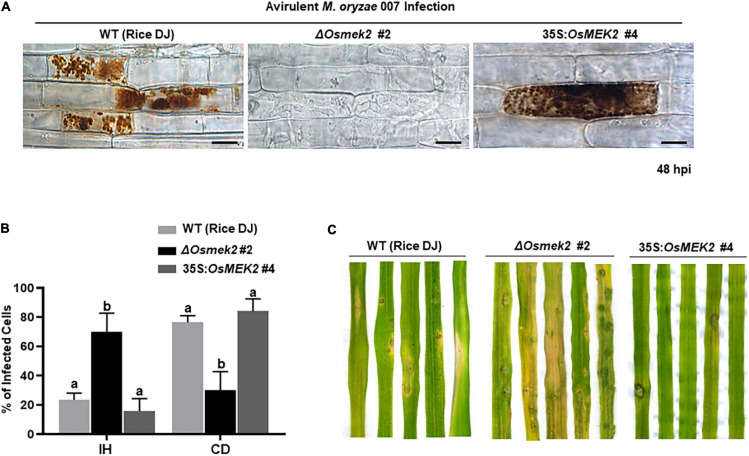FIGURE 3.
Avirulent Magnaporthe oryzae 007 infection causes susceptible responses in the ΔOsmek2 #2 knock-out plants, but resistant responses in the wild-type rice and 35S:OsMEK2 #4 overexpression plants. (A) Images of rice sheath epidermal cells infected with M. oryzae 007 (48 hpi). Rice leaf sheaths were inoculated with a conidial suspension (4 × 105 conidia mL–1). M. oryzae 007 grew well and produced invasive hyphae in the OsMEK2 knock-out (ΔOsmek2 #2) rice, but induced hypersensitive cell death in wild-type (WT) rice cultivar DJ and OsMEK2-overexpressed (35S:OsMEK2 #4) plants. Images were captured using a fluorescence microscope. hpi, hours post-inoculation. Scale bars = 20 μm. (B) Quantification of cell death and invasive hyphae in rice sheath cells infected with M. oryzae 007 (48 hpi). Results are presented as mean values ± SD; n = 4 leaf sheaths from different plants. Different letters above the bars indicate significantly different means (P < 0.05), as analyzed by Fisher’s protected least significant difference (LSD) test. IH, invasive hyphae; CD, cell death. (C) Disease types of rice leaves in wild-type rice (DJ), ΔOsmek2 #2 and 35:OsMEK2 #4 plants. Two-week-old rice seedlings were spray-inoculated with a conidial suspension (4 × 105 conidia mL–1) of M. oryzae 007. Diseased leaves were photographed at 5 days after inoculation. Disease types indicate a resistant-type lesion (necrotic brownish spots) and a susceptible-type lesion (large grayish, and expanded lesions). Experiments were repeated three times with similar results.

